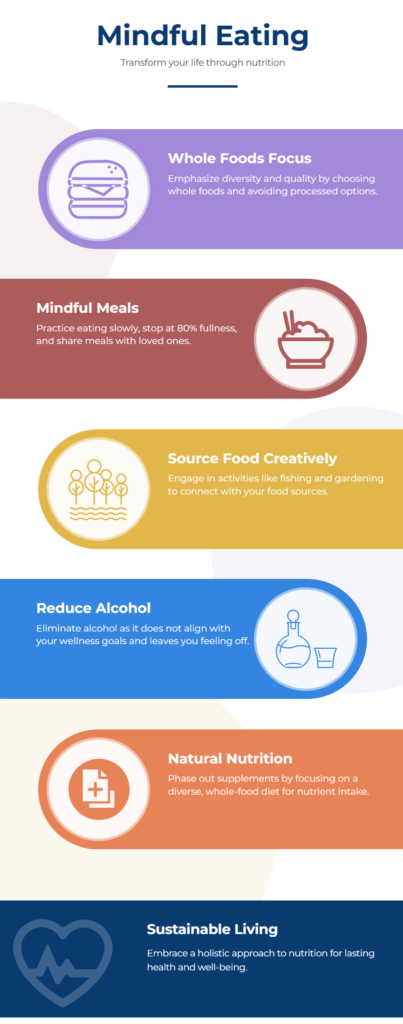Don’t miss a post. Click here to sign up for our free newsletter.
Estimated reading time: 6 minutes
Mindful Eating
Over the past two years, my personal health journey has been nothing short of transformative. From being overweight and under-muscled, I’ve worked diligently to achieve a strong, lean body with healthy levels of body fat (currently around 10%). This journey required a focus on body composition changes, involving precise nutrition and exercise strategies. But now, as I’ve reached a point of maintenance rather than transformation, it’s time for a new phase—one that shifts from targeted interventions to a steady-state approach rooted in balance and sustainability.
This next step in my journey involves stepping back to see the bigger picture. It’s about embracing a holistic, system-level perspective on health and nutrition rather than the reductionist view that often dominates modern Western science. Here’s how I’m approaching this new phase and what I’ve learned along the way.
From Parts Thinking to Systems Thinking
When I began my journey, my focus was sharp and detailed—understandable, given my background as a scientist. I prioritized macro- and micronutrient optimization: getting enough protein, managing carb intake, and supplementing where needed. This detailed focus worked exceptionally well for achieving my goals of reducing body fat and increasing lean muscle. However, as I’ve reached a maintenance phase, I’ve started to recognize the limitations of this approach.
Western nutrition science often treats food as a collection of individual components: proteins, fats, carbs, vitamins, and minerals. This “nutritionism” can be incredibly effective for targeted interventions but may overlook the synergistic effects of whole foods and traditional eating patterns. Ancient wisdom, particularly from Asian cultures, emphasizes a holistic view—considering how food, preparation methods, and mealtime habits interact within a complex, interconnected system.
I’ve decided to zoom out from the nutrient-level focus and embrace a broader, more intuitive approach to food—one that prioritizes whole foods and traditional practices over meticulous counting and measuring.
The Plan: A Synthesis of Ancient Wisdom and Modern Research
My new plan aligns closely with Michael Pollan’s famous advice from In Defense of Food: “Eat food. Not too much. Mostly plants.” (https://amzn.to/40oT4k2) But I’ve tailored it to fit my personal lifestyle, preferences, and what I’ve learned about sustainable health.
1. Focus on Whole Foods
Instead of chasing an ideal macro profile, I’m emphasizing diversity and quality in my diet. I aim to eat a wide range of whole foods, prepared at home, that my grandmother would recognize. This means:
- A Mediterranean-style diet with plenty of vegetables, nuts, fruits, fish, meat, olive oil, and avocado.
- Avoiding processed foods whenever possible but allowing flexibility to make it realistic and sustainable (following an 80:20 rule).
- Buying from local producers and cooking meals at home. Living in Montana provides access to high-quality, free-range meat and fresh, local produce.
2. Slow Down and Enjoy Meals
Adopting mindful eating practices is an essential part of this phase. This involves:
- Eating slowly, a habit inspired by the French.
- Stopping when I’m about 80% full, a practice borrowed from Okinawan culture.
- Sharing meals with loved ones to foster connection and gratitude.
3. Get Closer to the Source
There’s something deeply satisfying about being directly involved in sourcing your food. For me, this means:
- Catching trout from Montana’s wild rivers.
- Growing my own salad greens and herbs.
These activities not only provide fresh, nutrient-rich food but also strengthen my connection to nature and the food I eat.
4. Say Goodbye to Alcohol
I’ve found that alcohol no longer aligns with my wellness goals. Every time I drink, it leaves me feeling “off,” and I simply don’t miss it. Removing alcohol has been a straightforward but impactful change.
5. Phase Out Supplements
While supplements played a role in my earlier phase, I’m now focusing on getting nutrients naturally through a diverse, whole-food diet. For most people with a well-rounded diet, supplements provide minimal added benefit.
6. Embrace Intermittent Fasting
Intermittent fasting has become a cornerstone of my approach. By starting breakfast late (around 10 a.m.) and having an early dinner (around 6 p.m.), I give my body ample time to digest, restore, and switch to fat-burning mode. This practice enhances metabolic flexibility and aligns with my long-term goals for energy and vitality.
The Science Behind the Mindful Eating Plan
The Mediterranean Diet: A Proven Blueprint for Health
Numerous studies support the Mediterranean diet as one of the healthiest eating patterns. Research published in The New England Journal of Medicine found that a Mediterranean diet supplemented with nuts or olive oil reduced the risk of cardiovascular events by approximately 30% compared to a low-fat diet.
This diet’s emphasis on whole foods, healthy fats, and plant-based ingredients aligns with both ancient wisdom and modern science.
The Benefits of Mindful Eating
Mindful eating practices, such as eating slowly and stopping before you’re full, have been linked to better digestion and improved satiety. A study in Appetite found that eating slowly reduced overall calorie intake and enhanced feelings of fullness, making it a valuable tool for maintaining a healthy weight.
Intermittent Fasting: More Than a Trend
Intermittent fasting has gained traction in recent years, and for good reason. Research in Cell Metabolism highlights its benefits, including improved insulin sensitivity, reduced inflammation, and enhanced metabolic flexibility. These effects support long-term health and make fasting a practical tool for maintaining body composition.
Encouraging Discussion
This new phase of my journey is as much about refining my approach as it is about inviting others to reflect on their own. Here are some questions to spark discussion:
- Have you ever tried shifting from a nutrient-focused approach to a whole-foods perspective? What did you learn?
- How do you balance modern science with traditional wisdom and cultural practices in your health strategy?
- What small changes have made the biggest impact on your long-term wellness?
- Have you found ways to make food sourcing—like gardening or fishing—a rewarding part of your lifestyle?
I’d love to hear your thoughts and experiences as I continue exploring this new phase. Let’s learn from each other and build a community of health and wellness enthusiasts who value balance, sustainability, and joy in our practices.
Looking Ahead
Coming full circle doesn’t mean returning to the exact starting point—it means arriving at a deeper understanding of what works for you. This phase of my journey is about integrating what I’ve learned, embracing simplicity, and finding joy in the process. I’m excited to see where this path leads and to share insights along the way.
Let’s keep the conversation going. Share your thoughts, ask questions, and join me as we navigate the art and science of balanced living together.
👉 Start today!
Check out The Seven Pillars of Sustainable Health and Wellness, an introduction to our overall wellness coaching strategy.
Subscribe to our free newsletter to receive more health tips right in your inbox, or schedule a free 30-minute 1:1 call for a personal consultation.
Mindful Eating | Cheat Sheet

